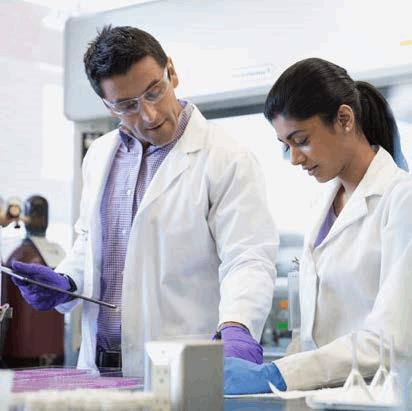Is Your In-House Strategy Ready For The Uncertainties Of Biologic Drug Development?
By John Ward, Vice President, Engineering, Thermo Fisher Scientific

The pharmaceutical industry’s past reliance on blockbuster drugs has evolved to include a focus on developing drugs that treat the unmet needs of smaller patient populations. These niche drugs most often come in the form of biologics, which are an increasingly larger share of new drug approvals in the past decade, from a low of 10 percent to a high of 27 percent.1 By 2022, 50 percent of the value of the top 100 products is expected to come from biologics.2
This proliferating number of targets has had a profound effect on the complexity and cost of drug development, which can take up to 15 years to complete and, as outlined in recent estimates, can cost up to $2.6 billion.3 Yet, despite the time and resources invested, only about 12 percent of the drug candidates that make it into Phase I testing are approved by the FDA.4 This is because drug development is complex and unpredictable, especially for biologics, which are developed by growing “live” cells in a bioreactor. Depending on the conditions, the results can vary with each batch. These characteristics make large molecule drugs much more challenging to bring to market than small molecule drugs. It also makes them more exciting, as the knowledge and expertise industry stands to gain from this new frontier could potentially change the face of medicine; however, a company has to be able to withstand the highs and lows of biologics development.
 To avoid costly mistakes and wasted efforts, a company must prepare for any surprises along the drug development pathway. One way to accomplish this is to diversify its strategies rather than develop only a single-pronged attack for launching a product. This flexibility creates the opportunity to incorporate multiple solutions if necessary. By adopting an operational approach that minimizes risk and optimizes drug development, a drug developer can successfully manage its product portfolio and reach its commercial goals. But is it possible to achieve efficiency and flexibility within a drug developer’s own walls, or is outsourcing pharma’s best not-so-secret weapon against today’s development uncertainties?
To avoid costly mistakes and wasted efforts, a company must prepare for any surprises along the drug development pathway. One way to accomplish this is to diversify its strategies rather than develop only a single-pronged attack for launching a product. This flexibility creates the opportunity to incorporate multiple solutions if necessary. By adopting an operational approach that minimizes risk and optimizes drug development, a drug developer can successfully manage its product portfolio and reach its commercial goals. But is it possible to achieve efficiency and flexibility within a drug developer’s own walls, or is outsourcing pharma’s best not-so-secret weapon against today’s development uncertainties?
Below are two main areas where a drug developer can face significant obstacles during biologics development. By evaluating these capabilities, a drug developer can answer the critical question of whether its in-house strategy is ready for the uncertainties of drug development.
Capacity: Is your facility prepared for the demands of today’s biologics pipeline?
As part of pharma’s evolution, the demand for capacity in biopharma is changing. An increased focus on process technology improvements in pharma over the last 20 years has resulted in much higher yields, enabling pharma to reduce its programs and products to smaller capacities. These new production processes and capabilities, such as perfusion and continuous processing, are driven not just by the need for smaller batches but also by the complexity and instability of biologics. Other operational capabilities like single-use technology (SUT) and online buffer conditioning offer additional major benefits, such as simplified logistics. While these technologies have become more sophisticated, they can still be difficult to apply in production. Until these technologies further advance, pharma manufacturers must come up with a more feasible plan to achieve flexibility and efficiency in this new manufacturing landscape. This is especially important, as a recent study by the American Pharmaceutical Review shows that half of all products projected in the future can likely be met with a 5,000-liter bioreactor or smaller per product.5 Fortunately, the emergence of SUT has brought promise to manufacturers that need to quickly expand capacity and have the resources to invest into this transition. SUT offers the flexibility needed for bio’s future, and with facilities taking 12 to 18 months to build (as opposed to the timeline for stainless steel facilities of five to six years for large-scale), it is an attractive solution to a growing need for capacity in a shorter period of time.
Nevertheless, a manufacturer cannot take full advantage of the benefits of any facility type if the demand forecast it relies on is inaccurate. In lower-throughput scenarios, SUT is often a more sensible route. As your throughput increases, the economics start to shift to stainless steel, as the cost of SUT components can be expensive in a high-demand scenario. Without the ability to accurately predict demand, though, there is no way to really know which facility type is best for your product.
 Considering the substantial costs of producing and storing biologics, the implications of an inaccurate forecast can be far-reaching. When demand is overestimated, companies are left with unused product and the likelihood of a significant loss in unproductive investments. This affects the company, its employees and its stakeholders. If it is underestimated, a manufacturer is left scrambling to come up with enough product to meet demand and creates new opportunities for its competition. As it attempts to come up with the needed capacity, the upfront costs of building infrastructure, hiring personnel and installing the necessary systems begin to mount. Meanwhile, patients in need of lifesaving drugs are left waiting for their medication. Still, the final product must be delivered quickly, at a reasonable cost and at the highest quality possible.
Considering the substantial costs of producing and storing biologics, the implications of an inaccurate forecast can be far-reaching. When demand is overestimated, companies are left with unused product and the likelihood of a significant loss in unproductive investments. This affects the company, its employees and its stakeholders. If it is underestimated, a manufacturer is left scrambling to come up with enough product to meet demand and creates new opportunities for its competition. As it attempts to come up with the needed capacity, the upfront costs of building infrastructure, hiring personnel and installing the necessary systems begin to mount. Meanwhile, patients in need of lifesaving drugs are left waiting for their medication. Still, the final product must be delivered quickly, at a reasonable cost and at the highest quality possible.
Experience: “The better you putt, the bolder you play.”
American golfer Don January once said the quote above to describe the risks a golfer is willing to take with their shot if they know they have the skills to face — and prevail over — a complicated situation on the green. Putting is difficult, and improving at it requires a lot of practice. The same can be said for developing biologics. A drug developer that is confident its team has the necessary skills to overcome the challenges of biologics development is more likely to keep its business in-house. But a small to midsize innovator company usually does not have the resources to staff a large team of experts. Therefore, it becomes unlikely they have the resources and experience not only to foresee potential issues but also to quickly come up with a solution that does not have a long-term impact on a product’s timeline and development costs.
For example, technology transfers are a critical step and necessary even in an in-house scenario, as multiple sites separating process development and manufacturing can exist. According to the ICH Q10 guidance6, “The goal of technology transfer activities is to transfer product and process knowledge between development and manufacturing, and within or between manufacturing sites to achieve product realization. This knowledge forms the basis for the manufacturing process, control strategy, process validation approach and ongoing continual improvement.” In other words, it is passing on the “recipe” for your product, and there is no room for error. For platform processes, such as a standard 2,000-liter fed batch, there is not much change in the standard operating procedures (SOPs) and batch records used from one process to the next. If a process is designed to the platform, and it works at a small scale, a company mitigates the risks at scale-up. However, for custom processes, particularly with biologics, it can be much more difficult to maintain the integrity of a drug’s formulation. If the integrity is not maintained, that manufacturer suddenly finds itself in a situation downstream where unexpected variables, such as extraneous protein or unpredicted scale-up issues, have a negative impact on the final product.
There is much to be said about the advantages of the technical knowledge that can be gained from running a variety of campaign types using multiple types of processes, such as in the tech transfer example above. The experience of analyzing and solving a wide range of process and product issues creates a much stronger skill set than only having to address a handful of problems with one product type each year. This strategic advantage translates to a higher level of expertise in both operations and development. A drug developer must consider how much practice its team has “on the green,” and if they are prepared with the boldness manufacturing biologics requires. If the decision is to not enter into a partnership, a company is placing itself into a silo and potentially at risk of not having access to necessary expertise. This makes it imperative its team has the know-how to work with biologics.
That expertise also extends to the regulatory side. More processes moving through a plant results in more agency inspections. This builds a stronger, broader understanding of the regulatory framework as well as a familiarity of the agency with the company itself, which can facilitate and even expedite a product’s speed to market. In addition, a drug developer must be able to recognize the impact of changes that can occur during development and how this affects the final formulation (and, thus, its approval). For example, what happens when a drug’s intended delivery system is initially an auto injector, but the concentration ultimately requires a dose higher than the 3-milliliter max of that system? The in-house team must have the knowledge not only to recognize any modifications it needs to make to manufacturing plans but also to understand how it might change the regulatory pathway originally intended for that product.
Summary
Overall, the decision to stay in-house or to outsource is not easy, but it is quite possibly the most important one you will make as you begin your journey into the production of biologics.7 A company venturing into this market might have a promising and potentially life-changing target; yet, it may not have the tools to successfully bring it to market. Partnering with a CDMO that offers flexible development and manufacturing solutions can help reduce the variability biopharma organizations often encounter during the drug development process; it also creates an ability to customize a solution that accounts for the ebb and flow of demand and capacity needs. Rather than relying on a strategy that claims to solve forecasting issues, a flexible solution allows a manufacturer to adjust to changes as they occur.
If a company determines capacity and expertise gaps exist in its strategy, the advantages of an experienced and flexible CDMO can be invaluable. Having the resources necessary helps mitigate the risks of drug development while creating an opportunity to achieve necessary speed-to-market milestones in a highly competitive market. By accessing pharma’s best weapon against development uncertainties, a manufacturer reaps the benefits of a cost effective solution that also provides the technical and business capabilities needed for commercial success.
- BioWorld, Biologics Share Of Medicine Chest Grows, And So Do Pricing Concerns — http://www. bioworld.com/content/biologics-share-medicine- chest-grows-and-so-do-pricing-concerns
- EvaluatePharma, World Preview 2016, Outlook to 2022 — http://info.evaluategroup.com/rs/607- YGS-364/images/wp16.pdf
- Tufts Center for the Study of Drug Development, Tufts CSDD Assessment of Cost to Develop and Win Marketing Approval for a New Drug Now Published — http://csdd.tufts.edu/news/complete_ story/tufts_csdd_rd_cost_study_now_published
- PhRMA, 2015 Profile, Biopharmaceutical Research Industry — http://www.phrma.org/sites/default/ files/pdf/2015_phrma_profile.pdf
- American Pharmaceutical Review, Global Biomanufacturing Trends, Capacity, and Technology Drivers: Industry Biomanufacturing Capacity Overview — http://www. americanpharmaceuticalreview.com/Featured- Articles/188840-Global-Biomanufacturing-Trends- Capacity-and-Technology-Drivers-Industry- Biomanufacturing-Capacity-Overview/
- International Conference on Harmonisation of Technical Requirements for Pharmaceuticals for Human Use, Guidance for Industry Q10 Pharmaceutical Quality System — https://www.fda. gov/downloads/Drugs/.../Guidances/ucm073517.pdf
- Lam, Stephen, Managing Demand Uncertainty in Biologics Production — http://go.patheon.com/ rs/910-ISZ-451/images/Whitepaper_FBM_ ManagingDemandUncertainty.pdf
